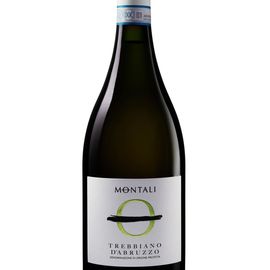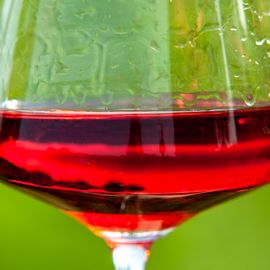Nature and Passion: A Perfect Blend
Authentic wines, naturally crafted. Discover our sustainable approach to quality.
/284x284/company-logo/ba/24/03/ba2403dbef64939ab8ff6cda10b7c56af9c8fed9/loogo.png)
Products

Trebbiano d'Abruzzo DOP
The quality of this wine is strictly derived from Trebbiano DOC grapes.
The harvest occurs from the third week of September and is rigorously handmade in crates of about 16 kg.
The harvested grapes are chilled in a refrigerated cell for about 16 to 24 hours to maximize the aromatic profile of this Abruzzese grape, which is rightly experiencing its best seasons and recognition.
Once the stay in the refrigerated cell is over, the grapes are destemmed and gently crushed. These are then transferred to the press where they sit for a few hours for a brief pellicular maceration to amplify better the must, which is subsequently pressed very gently.
The resulting must is transferred into concrete tanks and left to decant in cold temperatures. Once cleaned, the must is sent toward alcoholic fermentation at a controlled temperature of 14/16°C. This is a process that goes on for approximately a couple of weeks.
Once this stage is completed, the wine remains in close contact with the lees for about 5-6 months and is occasionally stirred to make it more refined both to the nose and to the taste. Finally, the wine is prepped
and bottled at the end of this period.
The wine resulting from this attentive process is a bright "straw yellow" color.
To the nose, scents of almond and annurca apple are perceived, and when tasted the wine is of excellent
persistence always accompanied by a pleasant sourness for a drink that never gets old.
An all-nervous wine that leaves an indelible signature, just like an Abruzzi soil knows how to deliver.
Alcohol content 12.50°.
Origin
이탈리아
Winery
Montali
Wine Region
이탈리아 / Abruzzo / Trebbiano d‘Abruzzo
Variety
100%
Vintage
2022
+9

Abruzzo Pecorino DOP
This wine is made exclusively of Pecorino DOC grapes.
The harvest falls on the first 10 days of September. The grapes, rigorously hand-picked in crates of about 16 kg, are put in the refrigerator to cool for about 16/24 hours.
Then the still chilled grapes are destemmed and lightly crushed. Consequently, these are transferred to the press for a few hours for pellicular maceration. To follow, the destemmed grapes are softly pressed under very low pressure and the resulting must is left to decant in cold temperatures for about 24 hours, then
poured to be cleaned of the lees and lastly, they are inoculated to ferment.
This fermentation leaves the must to sit for approximately 10 days at a 15°C temperature.
Once alcoholic fermentation is over, the wine stays in contact with the fine lees "Sur Lies" to obtain wines with a greater taste-olfactory balance.
Both fermentation and aging take place in concrete tanks. This process goes on for about 5-6 months. The resulting wine has a straw-yellow color where citrus and yellow-fleshed fruit and herbs aromas are perceivable to the olfact.
The drink is fresh and firm with a fine structure accompanied by an aromatic note that is always well-pronounced and present.
Alcohol content 13°.
Origin
이탈리아
Winery
Montali
Wine Region
이탈리아 / Abruzzo
Variety
100%
Vintage
2022
+9


Cerasuolo d'Abruzzo Superiore DOP
This Cerasuolo d'Abruzzo comes from attentive viticulture and a winery that is converting to organic practices, seeking the highest quality among both the local goods and the peculiarity of the Montepulciano d'Abruzzo, an eclectic grape that ensures the production of wines with a well-defined soul.
The grapes harvested strictly by hand in the first week of October in crates of about 16 kg, after a resting period of about 16 to 24 hours in a cool cell, are then destemmed and lightly crushed.
The destemmed grapes are then transferred into the press where they are left for a few hours for a pellicular maceration. After this time has elapsed, the destemmed grapes are pressed very gently and the resulting must is then sent into the tank where it sits to decant in cold temperatures for about 24 hours.
Subsequently, it is separated from the coarse lees and inoculated for alcoholic fermentation.
The latter is performed at a controlled temperature of 15°C and goes on for about 10 days.
Once alcoholic fermentation is completed, the wine stays in close contact with the fine lees, and from time to time the must is subjected to a "batonnage" agitation for a few months so that the wine can naturally mellow out. Finally, once this period of refinement is over, the wine is prepped and bottled.
The wine that we taste from the glass is of a bright shade of pink called "cerasa". A fine scent of fresh and crunchy fruit such as cherry is discernible and when tasted, the wine is uniquely identified by its individuality bound to a particular soil and vineyard.
In the mouth, it is fresh, long-linear, and persistent with this note of crunchy cherry that never fades away.
Overall, it is a wine that can be drunk and enjoyed with pleasure.
Alcohol content 13.5°.
Origin
이탈리아
Winery
Montali
Wine Region
이탈리아 / Abruzzo / Cerasuolo d‘Abruzzo
Variety
100%
Vintage
2022
+8

Montepulciano d'Abruzzo DOP
This wine originates from the Pescaresi hills in the municipality of Manoppello, in Via dei Vigneti, at an altitude of about 200 meters above sea level.
The vineyard is 8 years old with a plant density of 4500 vines per hectare, and the training form is guyot.
The agronomic management is in a transitioning process towards BIO viticulture, with particular attention to the viticulture, which, together with the terroir, elevates the qualities of this grape variety that is the
foremost component of Abruzzo's viticulture.
The harvest usually takes place after the first ten days of October.
The hand-picked grapes stored in small crates of about 16 kg are immediately transferred to the cooling cells where they ought to rest for approximately 16 hours at a temperature of 4 ° C to ensure the finest
aromatic expression.
Fermentation takes place in concrete tanks where the grapes ferment and age for 9 months before being transferred into the bottles, where they will remain for another 6 months before being made available to
the market.
Upon visual inspection of the wine, the color is an intense red with purple highlights.
Red berries, such as blackberry and blueberry, and ripe cherry are perceivable on the nose, with hints of cinnamon.
On the palate, the wine is full-bodied and mouth-filling with a nicely textured tannin, which suggests that a long aging process is still to come.
This wine is to be paired with the typical cuisine of Abruzzo, such as a chitarra with meatballs or a nicely grilled meat and aged pecorino.
Alcohol content: 14°
Origin
이탈리아
Winery
Montali
Wine Region
이탈리아 / Abruzzo / Montepulciano d‘Abruzzo
Variety
100%
Vintage
2022
+9
By clicking “Accept Cookies,” I agree to provide cookies for statistical and personalized preference purposes. To learn more about our cookies, please read our Privacy Policy.